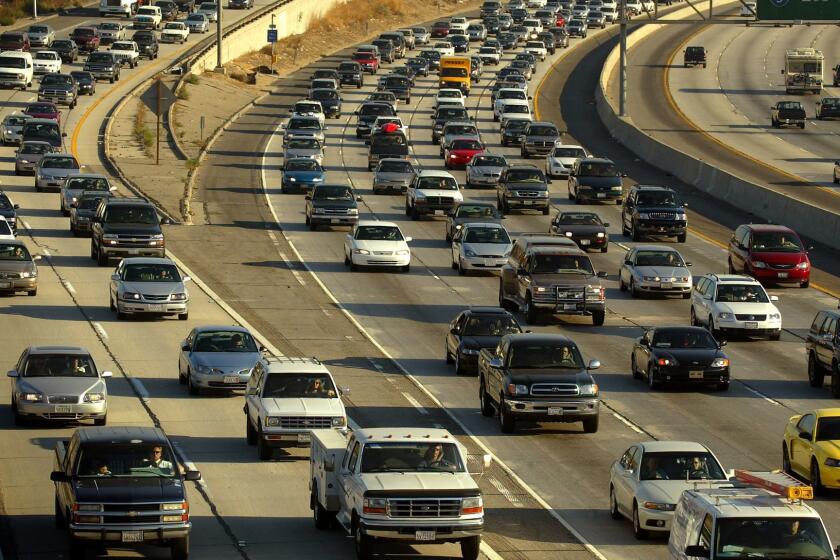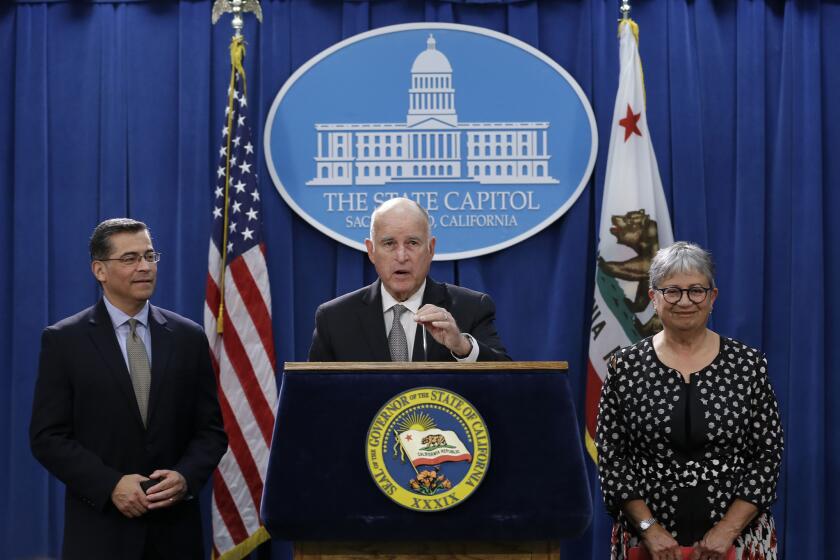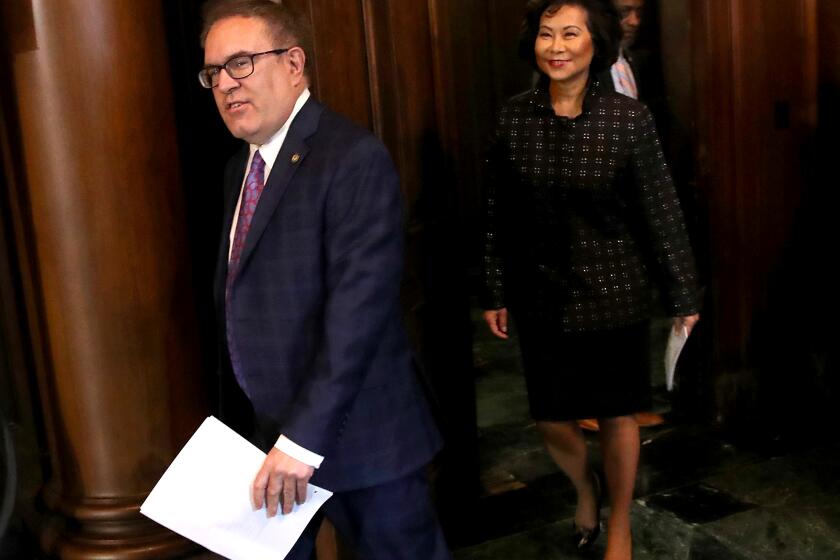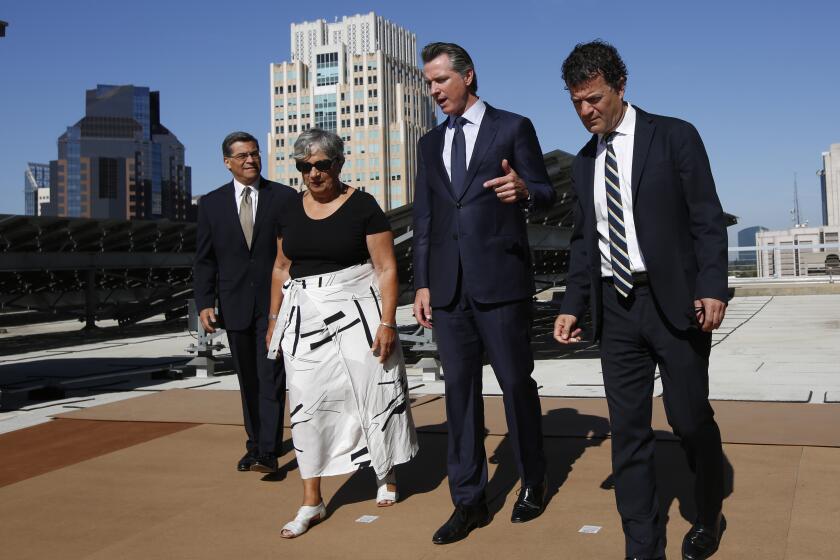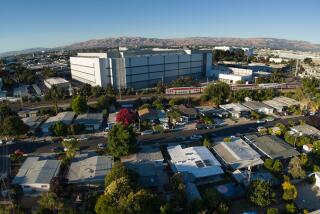Column: Will California have enough electricity for all its EVs? Yes — but it will take work
- Share via
Gov. Gavin Newsom’s order banning the sale of new gasoline vehicles in California by 2035 marked an audacious attempt to hasten the state’s transition toward climate-friendlier policies.
But the state’s likely shift toward millions more electric cars and trucks underscored a question that energy planners have been grappling with for several years: Will California have enough electricity to power all those vehicles?
The short answer is yes.
Executing the evolution of the grid has been described as rebuilding an airplane while it’s in flight.
— Chris Nelder, Rocky Mountain Institute
“There’s no technical or economic reason why the grid can’t support the full electrification of vehicles,” Chris Nelder, head of the EV-Grid Integration initiative at the Rocky Mountain Institute, told me.
The long answer is more complicated. California’s electrical capacity today wouldn’t be sufficient to provide power for 26 million EV cars and light trucks if all the vehicles in the state transitioned away from gasoline by 2035. “You’ll need to beef up the grid,” Nelder says.
Doubts about California’s ability to serve a vastly expanded fleet of electric vehicles were intensified by rolling blackouts imposed during two August days by the California Independent System Operator, or California ISO, which manages the state’s electrical grid. But experts say the rare confluence of circumstances that caused those outages don’t have anything to do with that issue. More on that in a moment.
Knowing how much more electrical capacity California will have a decade or two from now is a calculation bristling with uncertainties.
These include the pace of the transition away from gasoline-powered cars and the nature of the net technology — battery-powered electric cars? Hydrogen-fueled vehicles? Or some technology as yet lurking beyond the horizon? And will EVs become more efficient over time, reducing their demand for electricity to travel given distances?
One important variable involves the time of day when EV owners charge their vehicles. The conventional wisdom used to be that the best time was overnight, when overall electrical demand is at its lowest, for the same reason that time-of-use rate schedules are designed to encourage residents to run power-hungry washing machines and dishwashers late in the evening and early morning.
California’s transition to renewable energy, chiefly solar and wind power, has turned that notion on its head because solar power is overly abundant when the sun is shining.
California’s ban on gas-fueled vehicles calls the auto industry’s bluff on zero emissions
“There’s so much solar on the power grid now,” Nelder says, “that the new rates put forward by utilities have off-peak times in the middle of the day. So it makes more sense to charge your EV then.”
That adds another complication, however. Under normal circumstances (that is, pre-pandemic), cars used for work or commuting are away from home during the day. So the state’s electrical infrastructure will have to be reconfigured to encourage workplace owners and operators to provide charging stations for those vehicles.
That means, in turn, that utilities will have to beef up the electrical grid serving those locations to accommodate increased daytime usage.
The terms of Newsom’s order leaves open the pace of change in the transportation sector. Californians will still be allowed to drive gasoline-fueled vehicles after 2035, and to buy them in the used car market or import new vehicles from other states. They just won’t be allowed to buy new ones in-state.
The transition of Californian cars and light trucks from gas-guzzlers to EVs or other zero-emission technologies will depend partially on how long residents hold on to their old cars, which in turn is dependent on how long cars last and how quickly the cost of EVs falls to the level of conventional cars.
Critics of renewable energy such as President Trump point to the state’s supposed over-reliance on solar and wind power. The criticism is misplaced, however. The outages the California ISO ordered during a heat wave Aug. 14 and 15 were the product of an unusual combination of circumstances.
These included the unexpected shutdown of a natural gas-fueled generating plant, an unexpected delay in returning a second plant to service, smoke from wildfires that reduced the generating capacity of solar units, and the regional nature of the heat wave, which increased air conditioner use in states that ordinarily would be exporting electricity to California.
California’s emissions deal with five key automakers takes aim at Trump environmental rollbacks
The capacity-driven outages were California’s first since the energy crisis of 2000 and 2001. They weren’t repeated later in August or September even though local heat waves persisted and even intensified through the summer, though that doesn’t mean they might not recur in periods of intense weather; on Thursday, the California ISO issued an alert calling on users to voluntarily conserve power from 3 p.m. to 10 p.m., the period of heaviest usage, to avert rolling blackouts.
“The California blackouts led to a frenzy of hot takes and finger-pointing based on instant diagnoses of the problems,” Cheryl LaFleur, a former member of the Federal Energy Regulatory Commission, wrote on her Columbia University blog Sept. 2. In fact, she noted, the state’s renewable generation performed as designed.
The state’s capacity is sufficiently robust today to power the state’s estimated 670,000 plug-in hybrid and full-electric cars unless their owners all choose to plug in at the exact same moment, Nelder estimates. That inconceivable event would result in 4,670 megawatts of demand, Nelder estimates, bringing total demand to just over the 46,000 megawatts of maximum capacity estimated by California ISO.
Electrical demand in the state has fallen in relation to population over the last decade, according to the California Energy Commission, growing by less than 2% since 2009 while the population has grown by almost 7%.
Increases in demand at the grid level have been held down by improved efficiency in electric equipment and appliances and the growth of “behind-the-meter” solar — that is, residential installations, says Erica Bowman, director of resource and environmental planning and strategy at Southern California Edison.
That trend will fade over time, however, as efficiency gains top out and demand rises from EVs and the increased electrification of homes and commercial and industrial buildings.
But demand will ramp up slowly at first. “We’re not seeing a huge increase in load by 2030,” Bowman told me — even though the utility projects that EV ownership will rise to about 7.5 million vehicles, or about 25% of the state’s stock, based on expectations that about two-thirds of new vehicle sales will be EVs by then.
GM, Fiat Chrysler and Toyota, which are siding with Trump in his battle over California emissions rules, are among the worst performing carmakers on emissions.
By 2045, she says, Edison expects a 60% increase in demand relative to today.
That requires a massive investment in infrastructure. “You would have to build more generation, and you would also have to build more [transmission] capacity on your grid.”
Edison projects that the necessary change would require about $75 billion in transmission and distribution investment at California ISO’s level, but Bowman says that’s doable in that time frame.
All of this unfolds as utilities manage their way to meeting the state’s mandate that their retail sales — the electricity used by individual customers — be 100% carbon free by 2045.
Meeting the increased demand while also weaning California away from natural gas will require continued improvement in battery technology, so the intermittent generation of solar and wind units can be held over for periods when the sun has set and the wind stops blowing.
Trump’s authority to revoke California’s waiver from federal clean air rules rests on a very shaky legal foundation.
That technological challenge is being met, however, as utility-scale batteries have steadily become larger in capacity and lower in cost: The government’s Energy Information Administration estimates that the cost of energy storage fell by nearly two-thirds from 2015 to 2017 alone, from $2,153 to $834 per kilowatt-hour.
The most important element in the state’s transition to EVs may well be coordination, to counteract the effect of fragmented responsibilities for electrical generation, distribution and planning.
“In California,” LaFleur wrote, “the roles of the [California] ISO and the state regulators to keep the lights on are quite tangled.... In other words, the buck stops nowhere.” California ISO can direct the output of power plants but can’t require that they get built, she observed. Oversight of power plant construction rests with state regulators and is subject to local interests that may not be amenable to the siting of solar facilities or wind farms.
The transition from fossil-fuel to renewables generation hasn’t been well managed thus far, LaFleur maintains: “In the past three years, California has closed 5,000 megawatts of gas generation in anticipation of building 3,000 MW of battery storage that is still on the drawing board.” Having those batteries present and operating might have forestalled even the brief outages of mid-August.
“This is a very difficult thing to do,” Nelder says of planning a long-range transition of fundamental technologies. “It’s tricky.” The state will have to meet the growing demands of electricity users without overbuilding, which would raise the possibility of sticking consumers with unnecessary costs.
“You’re going to be criticized for overbuilding and criticized for underbuilding,” Nelder says. “Executing the evolution of the grid has been described as rebuilding an airplane while it’s in flight.”
For all that, California has been in the forefront of a necessary change in how we generate electricity and how we use it. The benefits of the transition are manifest — cleaner air and a smaller contribution to climate change among them.
Newsom’s goal of ending the sale of new gas-guzzling vehicles by 2035 is part of the broader change, but a necessary component. There may be many obstacles to making it happen in that time frame, but the lack of electricity shouldn’t be among them. Meeting the challenge of energy capacity is doable, and it needs to be done.
More to Read
Inside the business of entertainment
The Wide Shot brings you news, analysis and insights on everything from streaming wars to production — and what it all means for the future.
You may occasionally receive promotional content from the Los Angeles Times.

